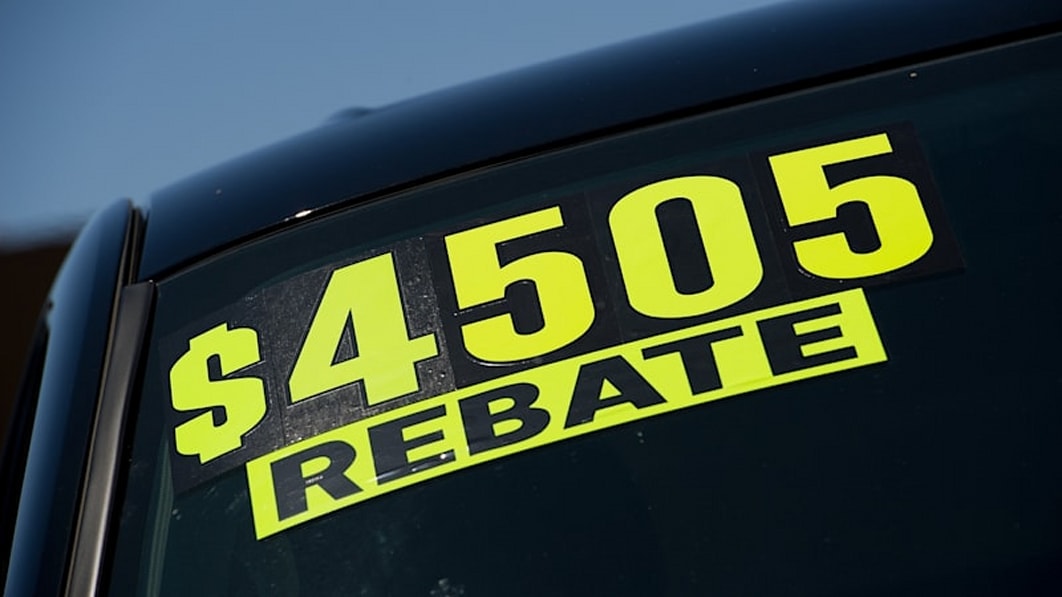What is a new car incentive or rebate?

This is part of our Car Buyer’s Glossary series breaking down all the terms you need to know if you’re buying a new or used car from a dealership.
Car dealers aren’t in the business of giving money away. They’re in the game to make a buck – and can you blame them? So is everyone else selling a consumer good. So when you hear about an incentive (that is, a rebate, low interest rate, or cash back offer), you should know what’s going on before you assume you’re getting a free lunch.
There are a few main types of incentive:
A cash-back or rebate offer
A low- or zero-percent interest offer
A factory-to-dealer incentive
On a very basic level, an incentive does one of two things for a car dealer: it gets people into the dealership, and it helps move out inventory. Let’s look at these both a little more closely.
The first part is basically the psychology of marketing. If you tell someone they can get $1,000 back on a new car deal, it might get them excited about (and invested in) the process. You might be a little less concerned about negotiating the price down since you’re getting money back. And the dealer has other avenues to make up that $1,000 – padding the interest rate a tiny bit or selling you some high-profit extra services, like an extended warranty. It’s a bit of a shell game – you’re focused on one thing, but the dealer has several ways to make a buck. The idea is you’ll be a bit distracted and or think you’re getting a better deal than you really are, and they can make some profit in other places. And that’s totally their prerogative.
The second is a little more helpful for consumers. Let’s say there’s a slow-selling car sitting on the lot. The dealer borrowed money from a lender to buy that car, hoping to sell it for a profit quickly so they pay minimal interest on the loan. Usually, dealers order what vehicles they want, using information about what sells well in the region and on their lot. Sometimes the manufacturer will hold back or allocate models based on dealer performance or other considerations, but it’s mostly up to the dealer what mix of vehicles are on the lot. Sometimes they get it wrong, or the car isn’t as hot as everyone hoped, and a car sits for longer than normal on the lot.
But those cars that won’t sell clog up the lot. They cost the dealer money, but more importantly, they take up room. Room that could be occupied by even more cars coming from the factory. Since the factory wants to sell all the cars they make, they don’t want the pipeline from factory to dealer and then owner clogged up by old inventory.
So another type of incentive is one that’s paid by the manufacturer to the dealer. It’s basically a little financial relief, and some motivation to lower the price a bit and get that old car off the lot to make room for a new one. This is called a “factory-to-dealer” incentive. You, the car buyer, won’t see it. And maybe the dealer will lower the price a bit, but maybe they’ll ask for full price and pocket that money from the factory.
It’s hard to find out about factory-to-dealer incentives, but there are a few sites that list them. You can use them to lower the price a bit on a slow-selling car, because it’s not money that’s coming out of the dealer’s bottom line.
The same applies to the other types of manufacturer incentives, which are generally advertised. You can use them to reduce the purchase price of the vehicle – which is something you should negotiate. They also don’t hurt the dealer’s bottom line.
So, with either factory-to-dealer or advertised manufacturer incentives, negotiate a low, fair price, and then subtract any rebates that apply. If the dealer is ok with the price you negotiated, they can’t complain too much if you want to share in the manufacturer-provided bounty.
Lastly, let’s talk about low- or zero-percent APR offers. There are two catches here, the first being that you have to have excellent credit to qualify for them. The dealer is hoping that you’ll be so committed to the deal that by the time the finance person tells you that you don’t qualify for it, you won’t feel like walking away. You’ll be psychologically invested.
The second is that you will almost certainly be locked into using the manufacturer’s captive lender – like Honda Financial Services or Ford Credit, to give you two random examples. That may be a problem for you, or may not.
Really, the dealer is trying to do two things with a low-interest rate loan: clear out inventory, or make money on other parts of the deal such as the purchase price or high-profit extras tacked on to the deal. The latter could be an extended warranty or an undercoating service – neither of which we recommend.
So there you go. Incentives are generally a good thing for savvy car buyers, and now that you know the basics of the three major types of incentive, you’ll be better equipped to use them to your advantage.



